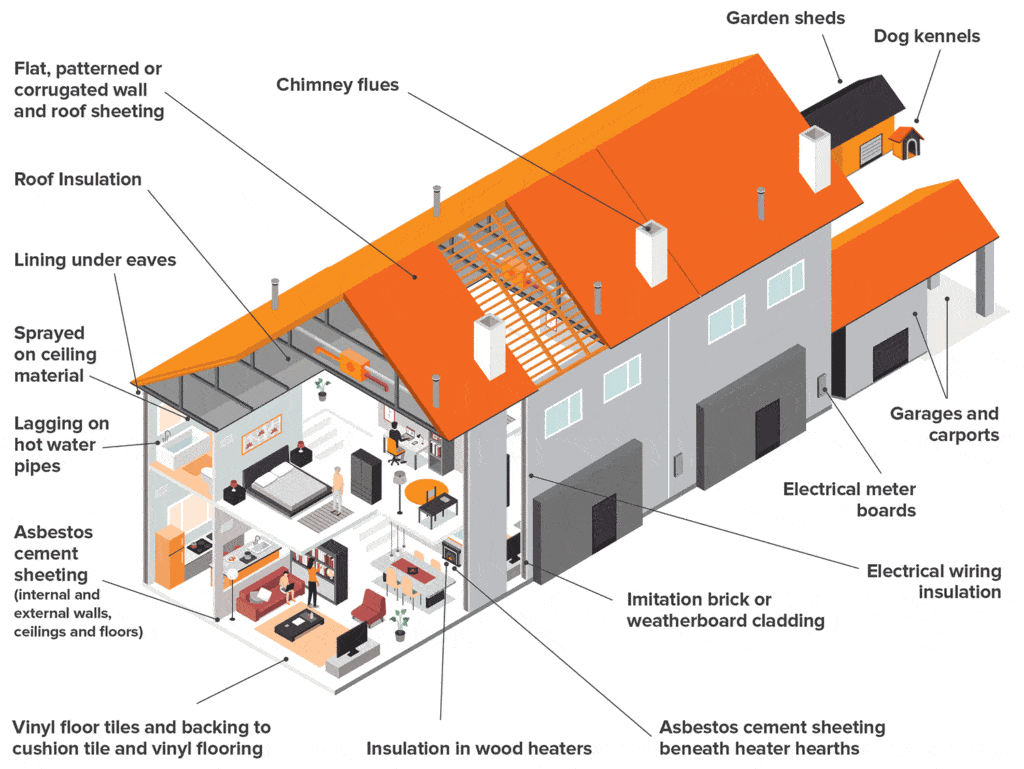Play it safe with asbestos
Asbestos is a term for a group of six naturally occurring mineral fibres. In the past, it was considered one of the most versatile minerals because of its properties of flexibility, strength, insulating from heat and electricity, chemical inertness and affordability. These same properties resulted in its extensive use over many years in Australia and it was commonly used in many industries including construction, shipbuilding, commercial product manufacturing and in power plants.
Unfortunately, the same properties make it extremely dangerous when inhaled because the microscopic fibres can lodge in the lungs and are unable to be expelled.
Asbestos is perhaps best known today for its role in causing mesothelioma, a rare and deadly cancer that can develop in linings of the lungs, abdomen or heart.
Where is asbestos commonly found?
The manufacture and use of asbestos products in residential construction was phased out in Australia, commencing in 1985. The ban was extended to cover all asbestos materials from 31 December 2003 and the ban now applies to importation, manufacture, supply, storage, sale, use, reuse, installation and replacement of asbestos.
Many strata complexes built up to 2003 contain asbestos products. Common uses were fibro sheeting (flat and profiled), guttering and downpipes, as well as pipes for water, drainage or flues, lagging, corrugated roofing sheets and roofing shingles.

Identifying the presence of asbestos
It can be difficult to identify the presence of asbestos by sight as it is a component of thousands of different products and building materials used in the community and industry since 1865.
As a general rule, if a property was built:
- before the mid-1980s, it is highly likely that it would have some materials containing asbestos;
- between the mid-1980s and 1990, it is likely that it would have materials containing asbestos;
- after 1990, it is unlikely that it would have materials containing asbestos.
The only way to check for asbestos is to have a sample of the material analysed by an accredited laboratory.
Tips to manage asbestos risks
In addition to managing risks and expenses, there are a range of actions to safely manage exposure to asbestos.
- Be vigilant, identify materials that may contain asbestos before contracting tradespeople to undertake work.
- If in doubt, arrange for testing of materials before work commences or, otherwise, treat materials as if they contain asbestos.
- Liaise with tradespeople to ensure they undertake work safely and in compliance with health and safety legislation.
- Ensure the removal of asbestos is only carried out under the authority of a suitably qualified and licenced asbestos removalist.
- Consult strata committees, lot owners, tenants and, if relevant, neighbours on planned work and any precautions required before the work commences.
- Leave undamaged asbestos material intact and undisturbed.
Insurance and asbestos
In Australia today, it is challenging to find strata insurance that includes cover for asbestos-related claims, whether for personal injury or property damage.
Asbestos checklist and register for strata complexes
An asbestos checklist and register may help identify if asbestos is an element of risk when undertaking repairs or renovation to a strata complex.
Incorrect removal of asbestos materials can cost hundreds of thousands of dollars to clean up and can include the removal, disposal and replacement of anything that makes contact with asbestos fibres, such as soil, plants, toys, clothing and soft furnishings.
In addition, removal of asbestos is highly regulated with severe penalties imposed for non-compliance.
1. Identify when the building was constructed
Asbestos was widely used as a construction and insulation material in buildings constructed before the late-1980s and, despite law changes from 1985, it was still being used in building developments up to 2003. Australia banned the use or importation of asbestos and asbestos products from 31 December 2003. It is worth noting that asbestos products have been identified in buildings as late as 2009.
If any of the strata properties you manage were built before 1990, it is more likely that they will contain asbestos, buildings up to 2003 may contain asbestos and after this date the presence of asbestos will be less likely. This information may help to take the right steps when a strata complex needs repair or renovation work.
2. Identify what materials were used in construction
Building materials could include timber, brick, steel, cement sheet or other material.
Friable asbestos products are generally quite loose and, when dry, can be crumbled into fine material or dust with very light pressure such as crushing with your hand. These products usually contain high levels of asbestos (up to 100% in some cases) which is loosely held in the product so that the asbestos fibres are easily released into the air.
If disturbed, friable asbestos products are dangerous because the asbestos fibres can get into the air very easily and may be inhaled by people living or working in the area.
Bonded asbestos products (non-friable) that have been damaged or badly weathered (including hail damage) may also become friable.
3. Do a walkthrough inspection to locate asbestos and create a register
An asbestos register is compulsory for commercial strata in most states due to Work, Health and Safety legislation (WHS) (a register is applicable for any scheme that does/could constitute a workplace). An asbestos register is also compulsory when work is being considered on a property where asbestos products have been identified.
It is recommended, however, that an asbestos register should be part of a good asbestos management plan for all strata complexes.
The register will help identify asbestos in a strata complex by recording location and condition of asbestos and measurements that are in place to manage the risk and the person responsible. It is a valuable tool when undertaking work and contracting external tradespeople or evidence of a well-managed complex when committee members change.
This register should be kept up-to-date and reviewed at least annually.
Insurance companies also may require an asbestos condition report and an asbestos management plan in any strata complex where asbestos products have been identified.
Please contact your local Strata Community Insurance team for a copy of our asbestos register.
This page’s content was last updated on 8 Jun 2020.
Download Resources
Download the “Play it safe with asbestos” PDF below.
Stay ahead with our strata insurance updates!

1. Ensure the site is safe
